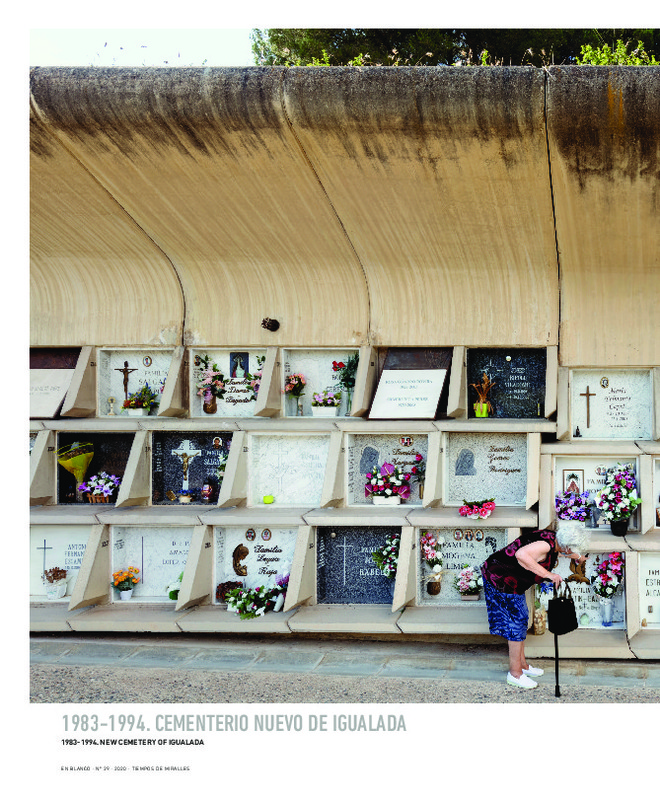JavaScript is disabled for your browser. Some features of this site may not work without it.
Buscar en RiuNet
Listar
Mi cuenta
Estadísticas
Ayuda RiuNet
Admin. UPV
Cementerio Nuevo de Igualada. O cómo construir un tiempo elástico
Mostrar el registro sencillo del ítem
Ficheros en el ítem
| dc.contributor.author | Blanco Herrero, Arturo
|
es_ES |
| dc.coverage.spatial | east=1.6372484; north=41.5922326; name=Carrer del Països Baixos, 23, 08700 Igualada, Barcelona, Espanya | es_ES |
| dc.date.accessioned | 2020-11-10T09:53:44Z | |
| dc.date.available | 2020-11-10T09:53:44Z | |
| dc.date.issued | 2020-10-29 | |
| dc.identifier.uri | http://hdl.handle.net/10251/154542 | |
| dc.description.abstract | [ES] Enric Miralles y Carme Pinós proponen un proceso atemporal en el cementerio de Igualada. Es un proceso voluntariamente inacabado donde el parámetro tiempo se hace flexible, dilatándose y contrayéndose para construir lo que ya estaba en ese lugar. La naturaleza antropizada recibe las acciones de Miralles y Pinós, transformándose y transformándolas recíprocamente. El hormigón armado se hace imprescindible en Igualada y se posiciona como un material obsesivo, utilizándose en sus múltiples registros incluso desestructurando sus elementos, separándolos, disgregándolos y desnudándolos, para después volverlos a juntar desde otro punto de vista. El cementerio de Igualada participa en un diálogo constante y especialmente contemporáneo donde lo inacabado es un fin. | es_ES |
| dc.description.abstract | [EN] Enric Miralles and Carme Pinós propose a timeless process in the cemetery of Igualada. It is a voluntarily unfinished process where the time parameter becomes flexible, expanding and contracting to build what was already there. Humanised nature receives the initiatives of Miralles and Pinós, mutually transforming and transforming each other. Reinforced concrete becomes essential in Igualada and it is considered as an obsessive material, used in its multiple registers and even destructuring its elements, separating them, breaking them up and baring them, to then reassemble them from another perspective. The cemetery of Igualada participates in a constant and especially contemporary dialogue where the unfinished is an end in itself. | es_ES |
| dc.language | Español | es_ES |
| dc.language | Inglés | es_ES |
| dc.publisher | Universitat Politècnica de València | es_ES |
| dc.relation.ispartof | EN BLANCO. Revista de Arquitectura | es_ES |
| dc.rights | Reconocimiento - No comercial - Sin obra derivada (by-nc-nd) | es_ES |
| dc.subject | Miralles | es_ES |
| dc.subject | Cemetery | es_ES |
| dc.subject | Elastic | es_ES |
| dc.subject | Unfinished | es_ES |
| dc.subject | Concrete. | es_ES |
| dc.subject | Cementerio | es_ES |
| dc.subject | Elástico | es_ES |
| dc.subject | Inacabado | es_ES |
| dc.subject | Hormigón. | es_ES |
| dc.title | Cementerio Nuevo de Igualada. O cómo construir un tiempo elástico | es_ES |
| dc.title.alternative | New Cemetery of Igualada. Or how to build flexible time | es_ES |
| dc.type | Artículo | es_ES |
| dc.identifier.doi | 10.4995/eb.2020.14376 | |
| dc.rights.accessRights | Abierto | es_ES |
| dc.description.bibliographicCitation | Blanco Herrero, A. (2020). Cementerio Nuevo de Igualada. O cómo construir un tiempo elástico. EN BLANCO. Revista de Arquitectura. 12(29):18-39. https://doi.org/10.4995/eb.2020.14376 | es_ES |
| dc.description.accrualMethod | OJS | es_ES |
| dc.relation.publisherversion | https://doi.org/10.4995/eb.2020.14376 | es_ES |
| dc.description.upvformatpinicio | 18 | es_ES |
| dc.description.upvformatpfin | 39 | es_ES |
| dc.type.version | info:eu-repo/semantics/publishedVersion | es_ES |
| dc.description.volume | 12 | es_ES |
| dc.description.issue | 29 | es_ES |
| dc.identifier.eissn | 1888-5616 | |
| dc.relation.pasarela | OJS\14376 | es_ES |








